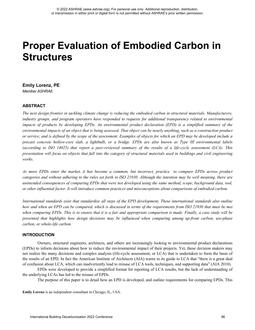
C13 — Proper Evaluation of Embodied Carbon in Structures
Click here to purchase
The next design frontier in tackling climate change is reducing the embodied carbon in structural materials. Manufacturers, industry groups, and program operators have responded to requests for additional transparency related to environmental impacts of products by developing EPDs. An environmental product declaration (EPD) is a simplified summary of the environmental impacts of an object that is being assessed. That object can be nearly anything, such as a construction product or service, and is defined by the scope of the assessment. Examples of objects for which an EPD may be developed include a precast concrete hollow-core slab, a lightbulb, or a bridge. EPDs are also known as Type III environmental labels (according to ISO 14025) that report a peer-reviewed summary of the results of a life-cycle assessment (LCA). This presentation will focus on objects that fall into the category of structural materials used in buildings and civil engineering works. As more EPDs enter the market, it has become a common, but incorrect, practice to compare EPDs across product categories and without adhering to the rules set forth in ISO 21930. Although the intention may be well meaning, there are unintended consequences of comparing EPDs that were not developed using the same method, scope, background data, tool, or other influential factor. It will introduce common practices and misconceptions about comparisons of embodied carbon. International standards exist that standardize all steps of the EPD development. These international standards also outline how and when an EPD can be compared, which is discussed in terms of the requirements from ISO 21930 that must be met when comparing EPDs. This is to ensure that it is a fair and appropriate comparison is made. Finally, a case study will be presented that highlights how design decisions may be influenced when comparing among up-front carbon, use-phase carbon, or whole-life carbon.
Product Details
- Published:
- 2022
- Number of Pages:
- 8
- Units of Measure:
- Dual
- File Size:
- 1 file , 1000 KB
- Product Code(s):
- D-94056-C13
- Note:
- This product is unavailable in Russia, Belarus


